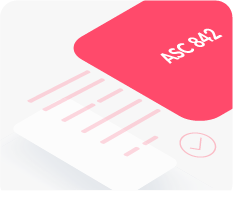
How to understand lease accounting journal entries (for lessees)
By
EZLease team
Recording journal entries appropriate for the lease accounting standard being tracked is critical for accurate financial reporting. Lessees need to carefully consider the terms of each lease agreement to determine which classification it falls under (i.e., Operating or Finance for lessees). Accounting for the leases will vary based on the classification.
Journal entries for different types of leases
Under ASC 842, an operating lease is a type of lease in which the lessee does not consume substantially all of the economic benefit of the leased asset over the reasonably certain lease term.
A finance lease is a type of lease in which the lessee consumes substantially all of the economic benefit of the leased asset over the reasonably certain lease term. In other words, the lessee takes on substantially all of the risks and rewards of ownership of the asset.
ASC 842 requires lessees to recognize a lease liability and a right-of-use asset on the balance sheet for all leases with a term of more than 12 months. The lease liability represents the present value of the lease payments, while the right-of-use asset represents the lessee’s right to use the underlying asset for the lease term.
Short team leases i.e., those with a reasonably certain term of 12 months or less) remain off-balance sheet and are accounted for in the same way as they were under ASC 840.
Operating lease journal entries
Under ASC 842, an operating lease is accounted for as follows:
Initial recognition of lease liability: The lessee should record a lease liability on their balance sheet, equal to the present value of the lease payments over the lease term. This amount should be discounted using the lessee’s incremental borrowing rate/Risk Free Rate (as applicable) or the interest rate implicit in the lease, if determinable. The lease liability will be further broken down into current and long-term liability portions and be credited when establishing the initial lease liability.
Initial recognition of right-of-use asset: The lessee should also record a right-of-use asset on their balance sheet, initially measured as the lease liability amount plus any initial direct costs incurred by the lessee minus any lease incentives. Right-of-use asset will be debited to establish the initial asset balance.
Subsequent measurement and amortization of lease liability: The lease liability shall be remeasured as necessary to reflect changes in the lease payments or lease term driven by lease lifecycle events such as modifications, extensions and certain kinds of payment adjustments. Each lease period will reclassify some portion of the long-term liability to the current liability resulting in a Debit to long-term liability and a credit to current liability. The liability is amortized over the reasonably certain lease term using the effective interest method.
Subsequent measurement and amortization of right-of-use asset: The right-of-use asset is measured initially at the lease liability amount, adjusted for any lease incentives received and initial direct costs incurred. The right of use asset is amortized using a method that is unique to ASC 842. The total lease expense remains flat from period to period. This includes the imputed interest that tapers as the liability is paid down, while the difference between the straight-line lease expense and the imputed interest (aka the plug) represents the imputed depreciation, which is credited to accumulated depreciation account.
Recognition of lease expense: The lessee recognizes lease expense on a straight-line basis over the lease term. The lease expense is recognized in the income statement as a single line item that includes both the imputed interest expense on the lease liability and the imputed amortization expense on the right-of-use asset, as explained in the above paragraph. Variations in lease payments that are not known in advance are expensed as incurred. These may be both positive and negative. Related executory costs such as maintenance, utilities etc. are also recorded in the period incurred, as operating expenses.
For short term leases, the lease expense is leveled over the reasonably certain term and any timing difference between lease payment and expense is parked in a deferred rent account.
Finance lease journal entries
Under ASC 842, a finance lease is accounted for as follows:
Initial recognition of lease liability: The lessee should record a lease liability on their balance sheet, equal to the present value of the lease payments over the lease term. This amount should be discounted using the lessee’s incremental borrowing rate/Risk Free Rate (as applicable) or the interest rate implicit in the lease, if determinable. The lease liability will be further broken down into current and long-term liability portions and be credited when establishing the initial lease liability.
Initial recognition of right-of-use asset: The lessee should also record a right-of-use asset on their balance sheet, initially measured as the lease liability amount plus any initial direct costs incurred by the lessee minus any lease incentives. The initial measurement of right-of-use asset will be debited to establish the initial measurement.
Subsequent measurement and amortization of lease liability: The lease liability shall be remeasured as necessary to reflect changes in the lease payments or lease term driven by lease lifecycle events such as modifications, extensions and certain kinds of payment adjustments. Each lease period will reclassify some portion of the long-term liability to the current liability resulting in a Debit to long-term liability and a credit to current liability. The liability is amortized over the reasonably certain lease term using the effective interest method.
Recognize interest expense and amortization expense: The lessee should recognize interest expense on the lease liability and amortization expense on the right-of-use asset over the lease term. The right-of-use asset needs to be amortized over the life of the lease (typically on a straight-line basis), except if the lease has a reasonably certain purchase option (RCPO) at the end of the lease term. If RCPO exists, the present value of the RCPO price is capitalized at lease commencement by debiting the right-of-use asset, and crediting liability for the expected purchase price. The Liability accretes interest over the term of the lease so that its credit balance equals the RCPO price at the end of the lease. The right-of-use asset (which includes the base asset and the PV of the RCPO price) is amortized over a term determined by the lessee’s depreciation policy for owned assets, depending on the asset class to which it belongs. Such amortization term is typically longer than the lease term.
ASC 842 and other lease accounting standards
Lease accounting standards, including ASC 842, IFRS 16 and those governed by the Government Accounting Standards Board (GASB 87 / GASB 96) carry different requirements for journal entries.
ASC 842 journal entries
ASC 842 applies to companies operating in United States and requires entities to use the modified retrospective method when adopting the new lease standards whereby entities are not required to restate prior period’s financial statements.
The standard requires all leases except short term leases to be recorded on the balance sheet as of the adoption date and there is no minimum threshold specified by the standard as a requirement of materiality.
IFRS 16 journal entries
IFRS 16 applies to entities where accounting is governed by the IASB outside of United States. One of the major differences is that IFRS 16 follows a single-model approach which means all leases are accounted for under the same accounting treatment. There is no concept of on- balance-sheet operating lease. All leases must be booked as finance leases on the balance sheet as long as the leases do not qualify as short term or the cost basis of the leased asset is below $5,000 equivalent, which is another key difference between IFRS 16 and ASC 842. The accounting between IFRS 16 and ASC 842 finance lease is very similar where the lessees must record the initial lease liability and right-of-use asset.
GASB 87 journal entries
GASB 87 accounting for the leases is very similar to IFRS 16. However, there are key differences which should be taken into consideration. GASB applies to all local and state government and many private non-profit institutions within United States whereas ASC 842 applies to all non-government for-profit entities and some non-profit entities. With regards to the approach, GASB 87 also uses single-model accounting approach where all leases are classified as finance leases as long as those are not short-term leases. The definition of short-term lease, however, has some subtle differences from IFRS 16, with regard to how renewal options are considered.
GASB 96 journal entries
Journal entries for GASB 96 are very similar to GASB 87 and both apply to government entities. One of the major differences is that GASB 96 applies to Subscription-Based Information Technology Arrangements such as cloud-based services arrangements or accounting/ERP system subscription arrangements.
Simplify lease accounting journal entries
EZLease lease accounting software is CPA-rated and gives you all of the tools you need to be compliant with the standards. We make it easy to track your leases, generate journal entries and reconcile your books.
Start your free trial or contact us if you have any questions.



